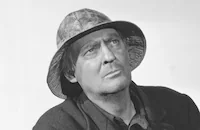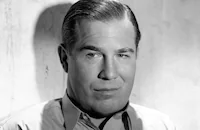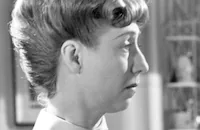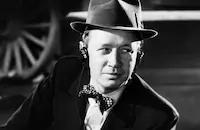Calling Dr. Gillespie

Brief Synopsis
Cast & Crew
Harold S. Bucquet
Lionel Barrymore
Philip Dorn
Donna Reed
Phil Brown
Nat Pendleton
Film Details
Technical Specs

Synopsis
Marcia Bradburn, who is completing her last year at Emma Hope's finishing school, is overjoyed that her father has given permission for her to become engaged to Roy Todwell. When she meets Roy in the school garden, he begs her to elope with him and becomes sullen when Marcia insists that they wait. Then suddenly, Roy throws a rock at his cocker spaniel and kills it after the dog wimpers at a train whistle. A sobbing Marcia goes to Emma, who calls her old friend, wheelchair-bound Dr. Leonard Gillespie of New York City's Blair General Hospital. Gillespie summons staff member Dr. John Hunter Gerniede, a surgeon who has recently arrived from Holland and wants to transfer to psychiatry. On Saturday evening, Gillespie and Gerniede go to a dance at the school so that Gerniede can surreptitiously observe Roy. Gerniede asks Marcia to take Roy to the spot where he killed the dog, and sees that Roy does not remember the incident. A few days later, after the boy has been examined at Blair, Gillespie and Gerniede tell Roy's parents that he has a serious mental illness that needs treatment. Because their family physician, Dr. Ward O. Kenwood, thinks that Roy has merely been working too hard at school, his parents refuse to accept Gillespie's diagnosis and take him home. That same afternoon, Marcia and Roy go shopping and while staring at a model train set in a store window, he becomes violent and tears the display apart. Marcia then goes to Dr. Gerniede and tells him what happened. Kenwood and Roy's parents still do not accept Roy's illness, but Marcia resolves to help him. At home, Roy imagines that Gillespie is against him and only pretends to take the sleeping medicine that Kenwood gives him. He then gets dressed and flees his room. Some time later, when Blair nurse Parker finds an unsigned, threatening postcard addressed to Gillespie, she shows it to hospital chief Dr. Walter Carew. Carew consults Gerniede, who thinks that he knows what is causing Roy's problems and, after calling Marcia, determines that loud piercing noises, such as train whistles, trigger Roy's violent outbursts. Hoping to keep the threats from Gillespie, Carew assigns muscular orderly Joe Wayman to act secretly as Gillespie's bodyguard. Meanwhile, in Detroit, Roy takes up with a dancehall girl named "Bubbles." Hoping to impress her, Roy arranges to purchase an expensive automobile C.O.D. The dealer and his mechanic then go to the address that Roy has given them, an unoccupied house, and Roy kills them both. That evening, at a restaurant, Roy goes to the men's room and hears a piercing sound, then walks out of the restaurant in a daze and kills a policeman. Some time later, when Marcia and Emma see Roy outside the school, they telephone Gerniede, who suggests that for her own protection, Marcia stay in his place at the hospital. After locking Marcia in his apartment, Gerniede discovers a broken picture of a train and knows that Roy is nearby. Although Carew initiates security procedures, Roy poses as a doctor and is able to get into Dr. Gillespie's unoccupied offices. When Gerniede goes to the office, he finds it empty, but discovers that a large scalpel is missing from a cabinet. He then goes to check on Marcia, who is not in the apartment. Meanwhile, in one of the hospital laboratories, Marcia, whom Roy had telephoned, approaches and begs him to call Gerniede. Although Roy says that he will kill Gillespie, he lets her call Gerniede to tell him where they are. When Gerniede, Gillespie and the police arrive, Gillespie convinces the police to let him and Gerniede talk privately with Roy. While pretending that he wants help, Roy secretly grabs a gun that he had earlier hidden in Gillespie's desk and is about to shoot when Joe enters the room and knocks the gun away. Several months later, Gerniede learns that he is being transferred to the psychiatry department, and Gillespie assures the graduating Marcia that Roy, who is now in prison, did not know what he was doing.

Director

Harold S. Bucquet
Cast

Lionel Barrymore

Philip Dorn

Donna Reed
Phil Brown

Nat Pendleton
Alma Kruger

Mary Nash

Walter Kingsford
Nell Craig
Ruth Tobey

Jonathan Hale

Charles Dingle

Marie Blake

Nana Bryant

Eddie Acuff
Robin Raymond

Emmett Vogan
Pat Mcvey

Hillary Brooke

Naomi Childers
Mary Currier
Barbara Coleman
George H. Reed
Philip Van Zandt
Charles Dorety
Harry Hayden
Frank Marlowe

Ray Teal
Pat Gleason

Joe Yule
Shirley Warde
Ernie Alexander
Edna Holland
William Newell
Harry Brown
Buddy Messinger
Charles R. Moore
Lew Leroy
Jerry Jerome

Ava Gardner
Anne Rooney
Charlotte Munier
Betty-jean Hainey
Jane Welborn
Crew
Daniele Amfitheatrof
Tom Andre
Lawrence P. Bachmann
Jerome Bresler
Malcolm Brown
Cedric Gibbons
Kubec Glasmon
Willis Goldbeck
Sydney Guilaroff
Ray June
Kalloch
Dr. Charles Mandell
Harry Ruskin
Bill Ryan
Douglas Shearer
Elmo Veron
Edwin B. Willis

Film Details
Technical Specs

Articles
Calling Dr. Gillespie
Marcia shares her concerns with the school headmistress who contacts her friend at Blair Hospital, the wheelchair bound psychiatrist Dr. Leonard Gillespie (Lionel Barrymore). Gillespie assigns an ambitious surgeon who aspires to be a psychiatrist, Dr. Gerniede (Philip Dorn) to quietly evaluate Roy Todwell's (Phil Brown) sanity. Gerniede finds that the troubled youth is deeply disturbed and likely to be sent into a violent rage again despite his parents' belief that he is harmless. When the boy goes on a homicidal rampage, the object of his fury is the doctor he holds responsible for his diagnosis, Dr. Gillespie. In the film's tense denouement Roy travels to Blair Hospital to kill him.
Astute viewers may recognize future movie goddess Ava Gardner, who appears briefly as one of Marcia's school classmates in the film.
Calling Dr. Gillespie (1942) was a spin off film from MGM's popular Dr. Kildare series. Along with the Thin Man and Andy Hardy franchises, it kept MGM in the black and it kept Reed busy. She appeared in Shadow of the Thin Man (1941), and the same year as Calling Dr. Gillespie's release, Reed made another girlfriend appearance as Andy Hardy's love interest in The Courtship of Andy Hardy.
The MGM Dr. Kildare series shifted focus when its star Lew Ayres declared conscientious objector status to World War II. He was taken off the film, making Dr. Gillespie the new story focus. Reed was outraged by Ayres treatment, as Jay Fultz recounted in his biography In Search of Donna Reed.
"He is a very intelligent, deep-thinking, kindly, generous person, and I admire him tremendously as a person who has the courage of his convictions. And then they send him away to a camp! I could go out and shoot a few people every time I think of it. It's a disgrace to democracy!"
An actress known for her wholesome, girl-next-door appeal, Reed was equally levelheaded and practical in her off screen life. A sensible girl, Reed stayed in business school even after attracting Hollywood's eye, so she would have something to fall back on if a career in the movies did not pan out. Having grown up on an Iowa farm during the Depression, Reed had experienced financial hardships and took nothing for granted. Even after Los Angeles City College elected Reed Campus Queen for the second time and Hollywood studios began to express interest in signing her to a movie contract, Reed continued in her studies.
After signing with MGM, Reed went through a series of name shifts, from Donna Mullenger to Donna Adams to Donna Drake until, as the legend goes, MGM casting agent Billy Grady settled on Donna Reed. Reed appeared in four or five films a year and built a reputation for her reliability as a sweet, wholesome love interest.
Reed wasn't entirely comfortable with her new name. As author Brenda Scott Royce quoted Reed, "I hear 'Donna Reed' and I get a picture of a tall, chic, austere blonde, which isn't me. I've never liked that name. It has a cold, forbidding sound."
After appearing in numerous MGM productions in minor pretty girl roles, Reed had her first real break at another studio.
A box office failure upon its initial release, the film that marked Reed's entry into film immortality was the 1946 Frank Capra drama she was loaned to RKO/Liberty Films for, It's a Wonderful Life. Though the film is unimaginable without Reed's gentle presence as Jimmy Stewart's devoted wife, a number of other actresses were considered for the role, like Jean Arthur, Olivia de Havilland, Martha Scott and Ann Dvorak.
The film set was tense, since both Capra and Stewart were nervous about rekindling their film careers in what was their first postwar production for both men. But the film nevertheless ended up the favorite movie of Capra, Stewart and Reed and proved a significant boost to Reed's career.
Director: Harold S. Bucquet
Screenplay: Willis Golbeck and Harry Ruskin from a story by Kubec Glasmon with characters created by Max Brand
Cinematography: Ray June
Production Design: Cedric Gibbons
Music: Daniele Amfitheatrof
Cast: Lionel Barrymore (Dr. Leonard Gillespie), Philip Dorn (Dr. John Hunter Gerniede), Phil Brown (Roy Todwell), Donna Reed (Marcia Bradburn), Nat Pendleton (Joe Wayman), Mary Nash (Emma Hope).
BW-84m.
by Felicia Feaster

Calling Dr. Gillespie
Quotes
Trivia
Notes
The characters of "Roy Todwell" and "Marcia Bradburn" reappeared in the 1943 film Dr. Gillespie's Criminal Case, in which "Gillespie" tries to obtain psychiatric help for Roy, who has been incarcerated, and who is eventually killed after a prison escape. Donna Reed reappeared as Marcia in the latter film, but Roy was portrayed by John Craven. According to a Hollywood Reporter news item, M-G-M wanted to borrow from Twentieth Century-Fox actor Frank Orth, who frequently appeared in the Kildare/Gillespie films as "Mike Ryan," owner of a tavern popular with "Blair General Hospital" staff members, but he did not appear in the released version of this film. Other actors mentioned in news items, whose appearances in the released film have not been confirmed, include: Barbara Bedford, Frances Raeburn, Monty Collins, Mitchell Lewis, Robert E. Keane and Ruth Dwyer.
News items, information in M-G-M story files at the USC Cinema-Television Library and the AMPAS Library file on Calling Dr. Gillespie reveal the following information about the production: The title of Kubec Glasmon's original story, written in June 1937, was Dr. Kildare's Triple X, and an early working title of the picture was Marked in Scarlet. It began filming in mid-February 1942 and shortly thereafter was known as Born to Be Bad. At that time, two months after the United States's entry into World War II, it was to be another in M-G-M's "Dr. Kildare" series, starring Lew Ayres as Kildare. In addition to Ayres, actress Ann Ayars was cast in the film, reprising the role of "Cookie Charles," a character she portrayed in Dr. Kildare's Victory, which was shot in October 1941, but was not yet released. A short time after shooting was completed on Born to Be Bad, Ayres declared himself a conscientious objector to war and was confined to an internment camp. News items in April 1942 noted boycotts by exhibitors of Ayres's films and adverse public reaction to his stance, although several news items reported some support for tolerance of Ayres's position. On April 3, 1942, well-known publicist Russell Birdwell took out a full-page ad in trade publications defending Ayres, and on April 13, 1942, a Hollywood Reporter article reported that ITOA theaters would continue to play Ayres's films because it was "inconsistent with Americanism" not to show them.
On April 14, 1942, Hollywood Reporter reported that Ayres had been reclassified by the government, thus decreasing the "fuss" over his unpopular stance, and on May 19, 1942, it was reported that he was serving in the U.S. Medical Corps. During the height of the controversy, however, M-G-M executives decided to re-shoot much of Born to be Bad to exclude the "Dr. Kildare" and "Cookie Charles" characters and turn it into a new film featuring "Dr. Gillespie" as the main character, yet retaining the central story of "Roy" and "Marcia." Philip Dorn was then selected to replace Ayres and the film's title was changed to Calling Dr. Gillespie. Most reviews still referred to it as a "Dr. Kildare" film, but all subsequent films in the series were called "Dr. Gillespie" pictures.
A number of actors were considered or tested for the part of Gillespie's new chief assistant. According to Hollywood Reporter, these included Rod Cameron, Dana Andrews, Cornel Wilde, Larry Parks and Charles Drake. According to news items in Hollywood Reporter in 1943, M-G-M was planning to have at least one film in the series feature a woman doctor. A script by M-G-M staff physician Dr. Helen Jones was to be directed by Willis Goldbeck and produced by Carey Wilson under the title Dr. Gillespie's Woman Doctor or Dr. Gillespie's Lady Doctor, but the film was never made. Van Johnson appeared in four Dr. Gillespie films from 1942 to 1944 as "Dr. Randall 'Red' Adams," a young physician aspiring to be Gillespie's chief assistant. In three of those films, Keye Luke as Chinese-American "Dr. Lee Wong How," portrayed Johnson's rival. Luke revived his character in the 1947 film, Dark Delusion, the last of the series (see below).
Born to Be Bad would have been Ayres' last M-G-M film. His last released M-G-M film was Fingers at the Window (see below). Ayres resumed his acting career in 1946 in The Dark Mirror (see below) and sporadically appeared in films and television over the next four decades. For additional information on the "Dr. Kildare" and "Dr. Gillespie" series, consult the Series Index and see entry to the 1938 film Young Dr. Kildare in AFI Catalog of Feature Films, 1931-40; F3.5251.















